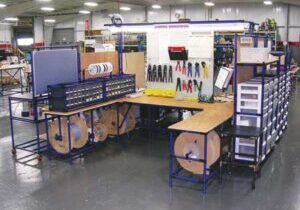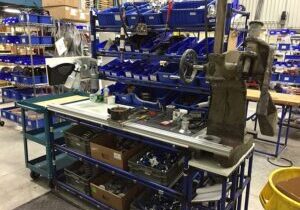Step-by-Step Facility-wide Implementation Roadmap
The phases of implementation including the objectives, step-by-step execution strategies, resource necessities, and timeline estimations for each phase.
By Andy Pritchard | February 5, 2022 | 5 minute read.
The successful implementation of 5S digitization in manufacturing and warehouses requires a thoughtful and strategic approach. This step-by-step guide outlines key considerations and actions to ensure a smooth transition to digital auditing processes.
We will outline the phases of implementation and rollout, detailing the objectives, step-by-step execution strategies, resource necessities, and timeline estimations for each phase.

Step-by-Step Facility-wide Implementation Roadmap
At this point in your journey, you should have a very good understanding of your digitization plan and the software you are going to use. Now it is time to dig into the exciting part: the implementation.
Step 1: Digitizing Forms and Schedules
Estimated Timeline: 1-2 months
Resource Requirements: Staff experienced in 5S auditing and adept at digital technologies for creating digital forms and schedules.
Overview: The goal of this phase is to transform your paper-based 5S auditing forms and schedules into digital formats. This phase involves the conversion of existing 5S documentation and schedules into digital formats compatible with the chosen software.
For more information download the guide.
Step 2: Pilot Program
Estimated Timeline: 1-2 months
Resource Requirements: Training team for the pilot, frontline and auditing Staff to execute pilot, Staff to collect and process feedback.
Overview: In this phase of the project, you will optimize the digital solution in a controlled environment before a full-scale rollout. A pilot program helps in identifying potential challenges and gathering user feedback in a more manageable, controlled setting.
For more information download the guide.
Step 3: Staff Training
Estimated Timeline: 1 month
Resource Requirements: Training personnel and environment
Overview: The goal of this phase is to ensure all stakeholders are proficient in using the digital platform. The Staff Training phase focuses on educating and training the entire staff to be comfortable and efficient in using the new digital system to execute 5S audits.
The scale of your staff training is relative to the amount of employees you are training, how much training you plan to provide and how complex the training content is. For example, if you are only training a few auditors on how to use a relatively simple platform, then the time and effort to train them will be less than if you are training dozens of auditors on a more complex system.
Operator training in most cases will only need to be an overview of the new auditing process and what to do when they are assigned an Action Item.
For more information download the guide.
Step 4: Facility-wide Rollout
Estimated Timeline: 2-3 months
Resource Requirements: Implementation team for overseeing the rollout and support staff for ongoing user assistance.
Overview: The Facility-wide rollout phase, the fourth step in a 5-phase 5S digitization implementation project, marks a pivotal moment in the journey towards a more efficient and organized workplace. With an estimated timeline of 2-3 months, this phase involves the full-scale deployment of the digital solution across the entire organization. It is a critical stage where careful monitoring, clear communication, and post-rollout assessments play essential roles in ensuring the successful adoption of the new system. During this phase, it's vital to have a dedicated implementation team overseeing the rollout and support staff readily available to assist users as they transition to the digital platform.
For more information download the guide.
Step 5: Measuring Results
Estimated Timeline: 3 months & ongoing
Resource Requirements: Data analysts and staff familiar with 5S practices for in-depth analysis.
Overview: The goal of this step is to measure the impact of digitization on 5S practices and overall operational efficiency. The initial measuring results phase should be completed and reviewed with company leadership within 2-3 months of the rollout implementation. However, monitoring and evaluation of the digital 5S auditing system's performance is recommended.
For more information download the guide.
Continue Reading
Why is 5S important?
5S is often one of the first lean manufacturing processes companies implement on their continuous improvement journey.
The Benefits of 5S
Aside from the cultural shift towards lean manufacturing that quick 5S wins can bring for your teams, there are over 50 years of well documented benefits worth discussing.
Practical Guide to 5S Sorting
How to effectively identify and remove unnecessary items from workstations to radically enhance productivity.
Overview of 5S Methodology
The 5S System is a lean manufacturing tool designed to improve efficiency and productivity in your plant by making it more organized and efficient.
How to Sustain with 5S Auditing
Practical guide to sustaining 5S and continuously improving workstation productivity.
How to Standardize in 5S
Ensure processes, procedures, and practices adhere to a defined standard, facilitating consistency and predictability in manufacturing.
How to Shine in 5S
A Practical Guide to Ensuring Workstations are Clean and Standardized for Success.
How to execute the 5S Set in Order Step
Practical guide for enhancing workstation orderliness to increase productivity, efficiency and employee engagement.
How to create a 5S Audit Checklist
The phases of implementation including the objectives, step-by-step execution strategies, resource necessities, and timeline estimations for each phase.
How does 5S work?
The 5S methodology is built on 5 easy to remember steps that have a natural flow to them as each step builds upon the success of the last.









